
Dresden is the capital city of the German state of Saxony and its second most populous city, after Leipzig. It is the 12th most populous city of Germany, the fourth largest by area, and the third most populous city in the area of former East Germany, after Berlin and Leipzig. Dresden's urban area comprises the towns of Freital, Pirna, Radebeul, Meißen (Meissen), Coswig, Radeberg and Heidenau and has around 790,000 inhabitants. The Dresden metropolitan area has approximately 1.34 million inhabitants.

The Elbe, historically in English also Elve, is one of the major rivers of Central Europe. It rises in the Giant Mountains of the northern Czech Republic before traversing much of Bohemia, then Germany and flowing into the North Sea at Cuxhaven, 110 kilometres northwest of Hamburg. Its total length is 1,094 km (680 mi).
Steinburg is a district in Schleswig-Holstein, Germany, administered from Itzehoe. It is bounded by the districts of Dithmarschen, Rendsburg-Eckernförde, Segeberg and Pinneberg, and by the Elbe River.
Herzogtum Lauenburg is the southernmost Kreis, or district, officially called Kreis Herzogtum Lauenburg, of Schleswig-Holstein, Germany. It is bordered by the district of Stormarn, the city of Lübeck, the state of Mecklenburg-Vorpommern, the state of Lower Saxony, and the city state of Hamburg. The district of Herzogtum Lauenburg is named after the former Duchy of Saxe-Lauenburg.
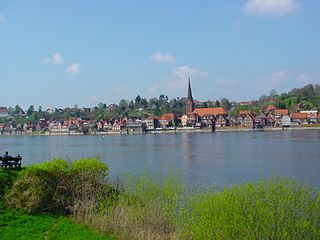
Lauenburg, or Lauenburg an der Elbe (Lauenburg/Elbe), is a town in the state of Schleswig-Holstein, Germany. It is situated on the northern bank of the river Elbe, east of Hamburg. It is the southernmost town of Schleswig-Holstein and belongs to the Kreis (district) of Herzogtum Lauenburg. Lauenburg had a recorded population on 31 December 2013 of 11,253.
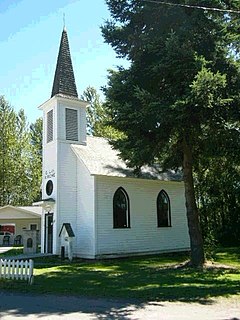
Elbe is a census-designated place (CDP) in Pierce County, Washington, United States. The population was 29 at the 2010 census.

The Havel is a river in northeastern Germany, flowing through the states of Mecklenburg-Vorpommern, Brandenburg, Berlin and Saxony-Anhalt. It is a right tributary of the Elbe and 325 kilometres (202 mi) long. However, the direct distance from its source to its mouth is only 94 kilometres (58 mi). For much of its length, the Havel is navigable; it provides an important link in the waterway connections between the east and west of Germany, as well as beyond.

Lili Ilse Elvenes, better known as Lili Elbe, was a Danish painter and transgender woman, and among the early recipients of sex reassignment surgery. She was a successful painter under her birth name Einar Wegener. After transitioning in 1930, she changed her legal name to Lili Ilse Elvenes and stopped painting; she later adopted the surname Elbe. She died from complications following a uterus transplant. The UK and US versions of her semi-autobiographical narrative were published posthumously in 1933 under the title Man into Woman: An Authentic Record of a Change of Sex.

Glückstadt is a town in the Steinburg district of Schleswig-Holstein, Germany. It is located on the right bank of the Lower Elbe at the confluence of the small Rhin river, about 45 km (28 mi) northwest of Altona. Glückstadt is part of the Hamburg Metropolitan Region.

The Elbe Sandstone Mountains, also called the Elbe Sandstone Highlands is a mountain range straddling the border between the state of Saxony in southeastern Germany and the North Bohemian region of the Czech Republic, with about three-quarters of the area lying on the German side. In both countries, core parts of the mountain range have been declared a national park. The name derives from the sandstone which was carved by erosion. The river Elbe breaks through the mountain range in a steep and narrow valley.
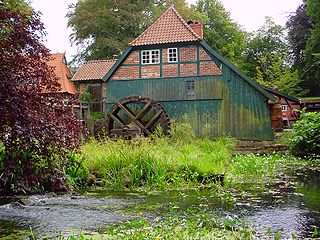
The river Bille is a small, slow-flowing German river in Stormarn, Schleswig-Holstein and Hamburg, a right tributary of the Elbe. Its source is near Linau, north of the heathland Hahnheide forest. It then flows south of Trittau, representing the border between Stormarn and Lauenburg, continues south of Reinbek and reaches the river Elbe near Billwerder. A lot of old estates and tasteful parks are laid out along its riverbank. Its total length is 65 km.

The Hermunduri, Hermanduri, Hermunduli, Hermonduri, or Hermonduli were an ancient Germanic tribe, who occupied an inland area near the source of the Elbe river, around what is now Bohemia from the first to the third century, though they have also been speculatively associate with Thuringia further north. According to an old proposal based on the similarty of the names, the Thuringii may have been the descendants of the Hermunduri. At times, they apparently moved to the Danube frontier with Rome. Claudius Ptolemy mentions neither tribe in his geography but instead the Teuriochaemae, who may also be connected to both.

The Heligoland Bight, also known as Helgoland Bight, is a bay which forms the southern part of the German Bight, itself a bay of the North Sea, located at the mouth of the Elbe river. The Heligoland Bight extends from the mouth of the Elbe to the islands of Heligoland and lies between the East Frisian island of Wangerooge and the North Frisian peninsula of Eiderstedt.

Elbe Day, April 25, 1945, is the day Soviet and American troops met at the Elbe River, near Torgau in Germany, marking an important step toward the end of World War II in Europe. This contact between the Soviets, advancing from the east, and the Americans, advancing from the west, meant that the two powers had effectively cut Germany in two.
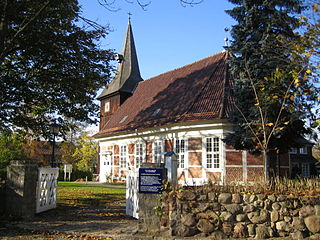
Geesthacht is the largest city in the District of the Duchy of Lauenburg in Schleswig-Holstein in Northern Germany, 34 kilometres (21 mi) south-east of Hamburg on the right bank of the River Elbe.

The Dresden Elbe Valley is a cultural landscape and former World Heritage Site stretching along the Elbe river in Dresden, the state capital of Saxony, Germany. The valley, extending for some 20 kilometres (12 mi) and passing through the Dresden Basin, is one of two major cultural landscapes built up over the centuries along the Central European river Elbe, along with the Dessau-Wörlitz Garden Realm downstream.

Encounter at the Elbe is a Soviet war film released in 1949 from Mosfilm, describing the conflict, spying, and collaboration between the Soviet Army advancing from the east and the U.S. Army advancing from the west. The two allied forces met each other for the first time on the River Elbe near the end of the World War II. This meeting occurred on April 25, 1945, which was usually remembered as “Elbe Day” in Western Bloc nations and as the "Encounter at the Elbe” in Eastern Bloc nations.

Wedeler Au is a river of Hamburg and Schleswig-Holstein, Germany. It flows into the Elbe near Wedel.
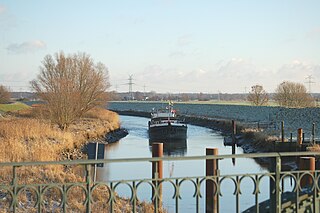
The Pinnau is a 41-kilometre-long (25 mi) river, which flows right or northeast of the main river, Elbe. The Pinnau is therefore a tributary in the southern part of Schleswig-Holstein, Germany.